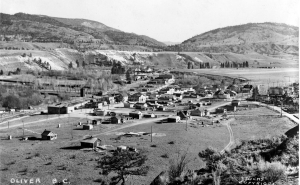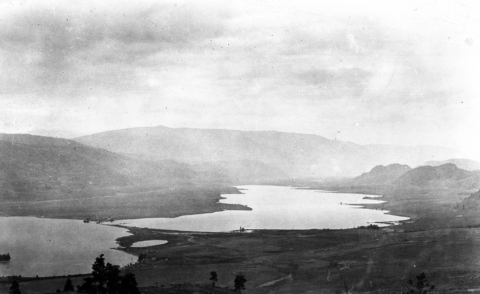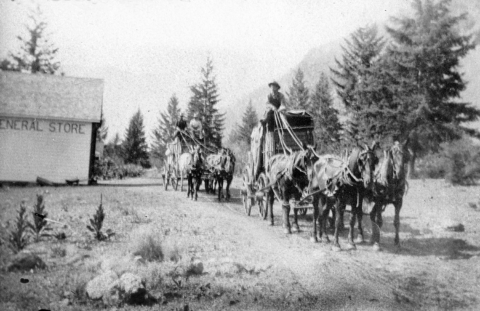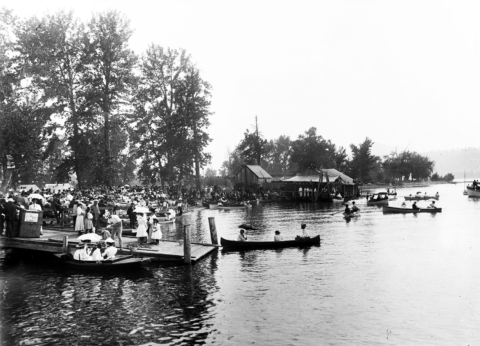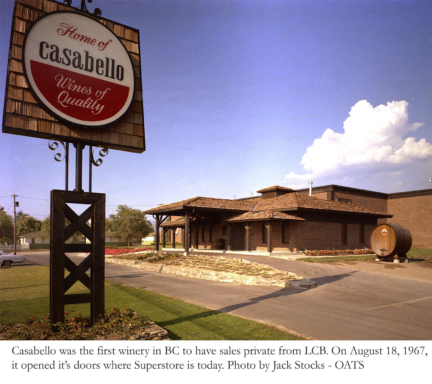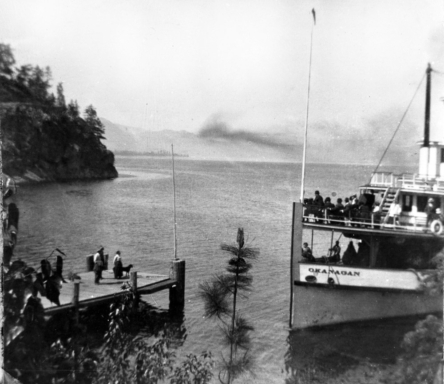The Story of the Creation of the Town of Oliver
Born in 1873 in Hubbards, Nova Scotia, Lytton Wilmot Shatford arrived in Vernon in 1893. He came to join his brother Walter who had established a dry-goods store in the downtown area of this north Okanagan city. Lytton had worked as a bookkeeper in Nova Scotia, so it was natural for him to assume that position with the store in Vernon.
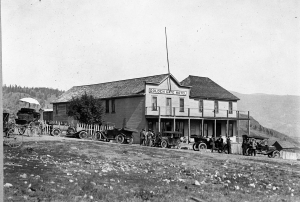
The success of the northern store and the arrival of the CPR opened incredible opportunities for the Shatfords, and they soon had stores in Fairview, Hedley, Camp McKinney, Sandon, and the Slocan. The wealth generated from these mining camps was considerable.
It is noted that Lytton was Mayor of Vernon in 1898-99, and was a staunch supporter of the British Columbia Conservatives. He worked diligently to rise in the party ranks until he was elected as the Similkameen Member of Parliament in 1903.
With the brothers’ success (there were four – Lytton, Walter, Shelborne and Beckford), and with investment capital available, it was natural that they look for opportunities in the valley. Walter liked Hedley and was happy running the store there. Beckford became one of the first fruit orchardists in Penticton, and Shelborne was raising his family in Vernon. He sat on Vernon Council from 1914 to 1919, three years as Mayor.
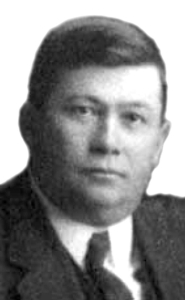
Lytton informed his brothers that he saw an opportunity in the Tom Ellis’ and Judge Haynes’ properties in the south. J.C. Haynes had passed away in 1888, and Tom Ellis had added his 21,000 acre ranch to his vast holdings. When Tom wanted to retire in the late 1890’s, he planned to market some of his property which reached from Naramata to the border, and was home to over 20,000 head of cattle. The only party interested in it all was the Shatford Brothers.
The Shatfords formed the South Okanagan Land Company in 1905, and made Tom Ellis an offer. They ended up paying Ellis $405,000 for most of the property. Tom did carve off a small chunk between the lakes for the townsite of Penticton before he happily retired to White Rock, where he lived in the lap of luxury until his death in 1918.
By 1907, the company had disposed of the Naramata/Cedar Creek section of their grazing lands to J.M Robinson for his townsite. There was rumour of railway surveys this year from both the US and Canada for the valley. They would be looking to purchase right-of-ways. Success just seemed to roll into the Shatford coffers.
Lytton liked the Fairview store and actually organized the local school, and sat as head of the school board. He accomplished this along with his services to the constituents as their MLA. From this office he was able to use his influence with the provincial government to secure water licences and easements through Native reserves for irrigation. The corporation understood that no subdivisions could be established without a continuous source of water.
By 1910, Lytton Shatford as our MLA, was also president of the British Columbia Life Assurance Company of Vancouver, vice-president of the Portland Cement Company in Princeton, president and managing director of the British Columbia Financial & Investment Company, director of the Bank of Vancouver, and in 1913 he was elected president of the B.C. Yukon Chamber of Mines. He was also a staunch Mason. It would have been impossible to refuse Mr. Shatford anything he proposed for the south Okanagan lands he and his company wanted to develop.
Lytton watched his businesses wind down with the declaration of war. Ranchers, construction workers and miners cleared out to join the Dominion forces fighting for King and Country. Even without this workforce, the Land Company continued work south of Okanagan Falls with the installation of an irrigation system at McIntyre Creek, just south of Vaseux Lake. But this installation did nothing to increase the interest in the subdivisions for sale in the area.
In 1917, Lytton Shatford was offered a Senate seat in the federal government of Robert Borden. The Similkameen seat went to William Alexander McKenzie, Mayor of Penticton.
As the war ended, our Senator became aware of the returning veterans and the difficulty they were having in procuring employment. Lytton was in need of a work force to complete the development of the Land Company holdings in the south Okanagan. He met with the Premier of B.C., John Oliver and his Minister of Lands T.C. Patullo. Oliver was a convert, and he began campaigning to pass the Soldier’s Land Act in the Provincial Legislature. The Premier had no problem passing his bill in 1918 as many of the MLAs had sons returning from service.
What this Act of the Legislature enabled Pattulo to do, was to raise funds to purchase a parcel of land from Shatford and the Land Company. A deal was drawn up for the purchase of 22,000 acres of land from the border to Okanagan Falls, along the Okanagan River. The price was $350,000. In 1919, the South Okanagan Lands Project was launched.
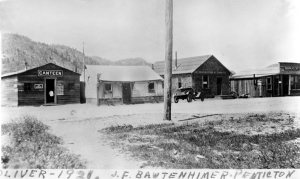
Returning veterans were given special purchasing privileges for the land to be developed. They could work on the water system for $5 for a 10 hour day and chose a five or ten acre parcel for 10% down of the $1000 (five acre) or $1000 (ten acre). Price per acre was half for the bigger parcel. If they made the payments for 5 years they would receive a $500 rebate. Irrigation rates would be an additional $6 per acre per year. A hundred and fifty men came for the first contract.
The project engineer was another close friend of Lytton Shatfords. Frank Latimer had laid out several irrigation plans for the Land Company in Penticton and had remained in their employ for 12 years. He was appointed Head Project Engineer by the Oliver Government and stayed to completion.
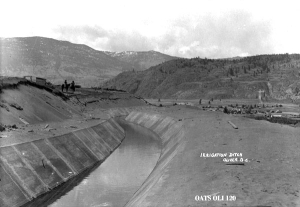 The first contract was given to retired Colonel A.E. Griffin of Vancouver. His company was to remove 250,000 cubic feet of dirt for the main ditch from McIntyre south. Work began in August 1919, during one of the hottest summers on record. Griffin employed the veterans as they walked off the train, as he had set up his office at the South Penticton KVR yards. They were shipped to a camp at the foot of Vaseux Lake or to the other camp further south below Fairview. Griffin brought in a mechanical shovel at McIntyre but work at Fairview was done with teams and scrapers.
The first contract was given to retired Colonel A.E. Griffin of Vancouver. His company was to remove 250,000 cubic feet of dirt for the main ditch from McIntyre south. Work began in August 1919, during one of the hottest summers on record. Griffin employed the veterans as they walked off the train, as he had set up his office at the South Penticton KVR yards. They were shipped to a camp at the foot of Vaseux Lake or to the other camp further south below Fairview. Griffin brought in a mechanical shovel at McIntyre but work at Fairview was done with teams and scrapers.
Griffin received a second contract to line the ditches with concrete when tests of the porous soil proved that the base was unstable. This work held back the completion of the canal and cost a small fortune. The project was only 10 miles long by 1923 and would not be completed to the border until 1927.
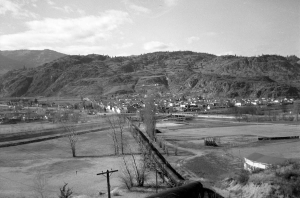 The complicated irrigation system was topped by the “Big Syphon”. Seven miles from the diversion dam, it was decided to build 2000 feet of stave pipe to bring water from the east to the west side of the valley. The pipe was six and a half feet in diameter and ran into 1600 feet of partially buried riveted steel pipe to bring water right into the townsite at considerable pressure. By 1926 a town was born. Of the 189 men who purchased farms from the program prior to 1926, all were still farming in the district by 1936.
The complicated irrigation system was topped by the “Big Syphon”. Seven miles from the diversion dam, it was decided to build 2000 feet of stave pipe to bring water from the east to the west side of the valley. The pipe was six and a half feet in diameter and ran into 1600 feet of partially buried riveted steel pipe to bring water right into the townsite at considerable pressure. By 1926 a town was born. Of the 189 men who purchased farms from the program prior to 1926, all were still farming in the district by 1936.
The largest of the work camps, Camp #4, was the home to over 400 workers and was located near where the Oliver KVR Depot is today. Fondly called “Canteen” due to the company store at the site, it became the first permanent site for the town. Because the Premier had such an effect on the area’s development, the veterans chose the name “Oliver” to honour their benefactor ‘Honest’ John Oliver.
Unfortunately, Lytton Shatford did not see the completion of the subdivision of his irrigated lands in the south. He died at his desk November 8th, 1920.

